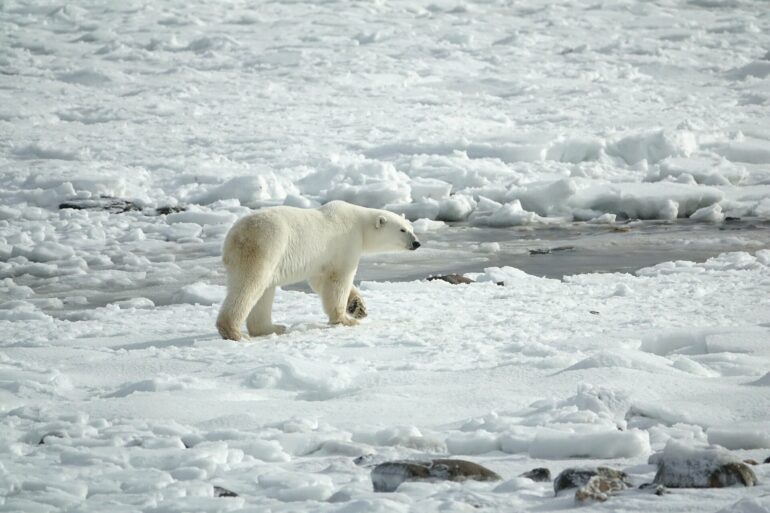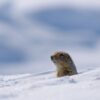The fact that polar bears in Greenland are under threat is not a recent development. They have increasingly come to symbolize the challenges posed by melting polar ice and the broader climate crisis in recent years. Nevertheless, a new study highlights that this trend has deep historical roots, with polar bear numbers in Greenland diminishing over a period of 20,000 years.
Assistant professor Michael Westbury and professor Eline Lorenzen at the Globe Institute are behind the new interdisciplinary study, which analyzes the DNA and food choices of living polar bears, as well as historical climate data and polar bear habitat around Greenland. The study, “Impact of Holocene environmental change on the evolutionary ecology of an Arctic top predator,” appears in Science Advances.
“By analyzing the genetic material from the polar bears, we can open a window into the past and gain an insight into the species’ development history and population history. Our analysis reveals that the number of polar bears has been significantly reduced several times since the last ice age,” says Eline Lorenzen.
But why has the polar bear been in retreat for such a long time? According to the study’s lead author, Michael Westbury, there is a simple explanation.
“It’s the rising sea temperatures that drive the decline in the polar bear population. When the sea temperature rises, there is less sea ice, and consequently, fewer seals, which polar bears feed on,” explains Michael Westbury.
What surprised the researchers and their colleagues the most when analyzing data was the significant impact of even a small change in the environment on polar bears.
“We see a disturbing connection between population decline and environmental changes. A relatively small increase in water temperature and a small reduction in the amount of sea ice result in a quite dramatic decline in the polar bear population. The relationship is not linear,” Michael Westbury continues.
The study was conducted in collaboration with colleagues from institutions in Greenland, Canada, Australia, Finland, Hong Kong, the UK, GEUS, and Aarhus University.
Will there be polar bears in Greenland in 50 years?
Due to increasing CO2 emissions, we have experienced global warming for many years—and it is clearly visible in Greenland and the Arctics.
“The current development is unprecedented compared to what the polar bear has experienced over the last 20,000 years. And with the drastic projections, we can expect that the species will not thrive at all,” says Michael Westbury.
The new study shows that the sea around Greenland has experienced a temperature increase of 0.2 to 0.5 degrees over the last 20,000 years, which, according to the analyses, has resulted in a 20–40% reduction in the polar bear population.
“Looking ahead, we are potentially facing a 2° to 5° increase in sea temperatures around Greenland. So, it’s a 10-fold increase in temperature changes compared to the last 20,000 years. It doesn’t look good for the polar bear. And as the top of the food chain, the polar bear represents ecosystem changes more generally, showing that marine ecosystems in the Arctic are under pressure,” adds Eline Lorenzen.
She points out that it is a symptom of something larger, and it’s not just in Greenland and the Arctic that ecosystems are negatively affected by climate change.
“It’s all of us. The Earth is a large, interconnected ecosystem, of which we are an integrated and deeply dependent part. Nature knows no boundaries,” says Eline Lorenzen.
A faint hope for the polar bear
The study suggests that polar bears can change what they eat, which could help them adjust to the climate changes.
“Our analyses of polar bear dietary choices show that they are plastic, meaning they can seek different food than usual. We can see this in the polar bears in East Greenland. There, it appears that male and female polar bears differentiate their dietary choices, so they do not compete with each other,” says Michael Westbury.
Males in East Greenland consume various seal species, while females eat ringed seals. According to Michael Westbury, this is something species can do when resources are scarce.
“We don’t see this in West Greenland, where our analyses show that genders eat the same. West Greenland has a significantly higher primary production due to ocean currents, providing more food available for polar bears,” says Michael Westbury.
The researchers utilized two independent datasets and methods to investigate the history of polar bears.
They employed the genetic diversity of Greenlandic polar bears to estimate the population history of polar bears over the last 20,000 years.
Additionally, they used the distribution of polar bears across the Arctic to map the environmental conditions, such as sea temperature and the amount of sea ice, in which polar bears thrive.
With corresponding historical environmental data, they then estimated the distribution and quantity of polar bear habitat over time, and how and when it has changed. The amount of available habitat serves as a proxy for population size; the more habitat available, the larger the polar bear population can be.
The results in population history based on DNA and environmental data turned out to be surprisingly similar over time. However, the relationship is not linear.
More information:
Michael V. Westbury et al, Impact of Holocene environmental change on the evolutionary ecology of an Arctic top predator, Science Advances (2023). DOI: 10.1126/sciadv.adf3326
Provided by
University of Copenhagen—The Faculty of Health and Medical Sciences
Citation:
For 20,000 years, polar bears have been retreating due to rising sea temperatures: Study (2023, November 10)



